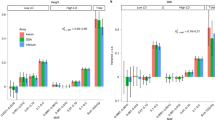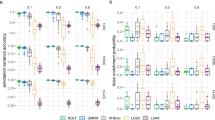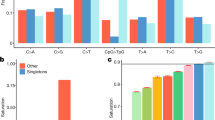Abstract
The laboratory rat is one of the most extensively studied model organisms. Inbred laboratory rat strains originated from limited Rattus norvegicus founder populations, and the inherited genetic variation provides an excellent resource for the correlation of genotype to phenotype. Here, we report a survey of genetic variation based on almost 3 million newly identified SNPs. We obtained accurate and complete genotypes for a subset of 20,238 SNPs across 167 distinct inbred rat strains, two rat recombinant inbred panels and an F2 intercross. Using 81% of these SNPs, we constructed high-density genetic maps, creating a large dataset of fully characterized SNPs for disease gene mapping. Our data characterize the population structure and illustrate the degree of linkage disequilibrium. We provide a detailed SNP map and demonstrate its utility for mapping of quantitative trait loci. This community resource is openly available and augments the genetic tools for this workhorse of physiological studies.
This is a preview of subscription content, access via your institution
Access options
Subscribe to this journal
Receive 12 print issues and online access
$209.00 per year
only $17.42 per issue
Buy this article
- Purchase on Springer Link
- Instant access to full article PDF
Prices may be subject to local taxes which are calculated during checkout


Similar content being viewed by others
Accession codes
Accessions
GenBank/EMBL/DDBJ
References
Jacob, H.J. & Kwitek, A.E. Rat genetics: attaching physiology and pharmacology to the genome. Nat. Rev. Genet. 3, 33–42 (2002).
Bihoreau, M.T. et al. A linkage map of the rat genome derived from three F2 crosses. Genome Res. 7, 434–440 (1997).
Guryev, V., Berezikov, E., Malik, R., Plasterk, R.H. & Cuppen, E. Single nucleotide polymorphisms associated with rat expressed sequences. Genome Res. 14, 1438–1443 (2004).
Zimdahl, H. et al. A SNP map of the rat genome generated from cDNA sequences. Science 303, 807 (2004).
Thomas, M.A., Chen, C.F., Jensen-Seaman, M.I., Tonellato, P.J. & Twigger, S.N. Phylogenetics of rat inbred strains. Mamm. Genome 14, 61–64 (2003).
Kurtz, T.W. & Morris, R.C. Jr. Biological variability in Wistar-Kyoto rats. Implications for research with the spontaneously hypertensive rat. Hypertension 10, 127–131 (1987).
Kurtz, T.W., Montano, M., Chan, L. & Kabra, P. Molecular evidence of genetic heterogeneity in Wistar-Kyoto rats: implications for research with the spontaneously hypertensive rat. Hypertension 13, 188–192 (1989).
Gauguier, D. The rat as a model physiological system. In Encyclopedia of Genetics vol. 3 (eds. Jorde, L.B., Little, P., Dunn, M. & Subramaniam, S.) 1154–1171 (Wiley, London, 2006).
Arbiza, L. et al. Selective pressures at a codon-level predict deleterious mutations in human disease genes. J. Mol. Biol. 358, 1390–1404 (2006).
Goñi, J.R., de la Cruz, X. & Orozco, M. Triplex-forming oligonucleotide target sequences in the human genome. Nucleic Acids Res. 32, 354–360 (2004).
Hedrich, H.J. (ed.) Genetic Monitoring of Inbred Strains of Rat (Gustav Fischer, Stuttgart, New York, 1990).
Huson, D.H. & Bryant, D. Application of phylogenetic networks in evolutionary studies. Mol. Biol. Evol. 23, 254–267 (2006).
Mashimo, T. et al. A set of highly informative rat simple sequence length polymorphism (SSLP) markers and genetically defined rat strains. BMC Genet. 7, 19 (2006).
Smits, B.M. et al. Efficient single nucleotide polymorphism discovery in laboratory rat strains using wild rat-derived SNP candidates. BMC Genomics 6, 170 (2005).
Gabriel, S.B. et al. The structure of haplotype blocks in the human genome. Science 296, 2225–2229 (2002).
Barrett, J.C., Fry, B., Maller, J. & Daly, M.J. Haploview: analysis and visualization of LD and haplotype maps. Bioinformatics 21, 263–265 (2005).
Wade, C.M. et al. The mosaic structure of variation in the laboratory mouse genome. Nature 420, 574–578 (2002).
Frazer, K.A. et al. A sequence-based variation map of 8.27 million SNPs in inbred mouse strains. Nature 448, 1050–1053 (2007).
Yang, H., Bell, T.A., Churchill, G.A. & Pardo-Manuel de Villena, F. On the subspecific origin of the laboratory mouse. Nat. Genet. 39, 1100–1107 (2007).
Lindblad-Toh, K. et al. Genome sequence, comparative analysis and haplotype structure of the domestic dog. Nature 438, 803–819 (2005).
Guryev, V. et al. Haplotype block structure is conserved across mammals. PLoS Genet. 2, e121 (2006).
Jensen-Seaman, M.I. et al. Comparative recombination rates in the rat, mouse, and human genomes. Genome Res. 14, 528–538 (2004).
Grupe, A. et al. In silico mapping of complex disease-related traits in mice. Science 292, 1915–1918 (2001).
Payseur, B.A. & Place, M. Prospects for association mapping in classical inbred mouse strains. Genetics 175, 1999–2008 (2007).
Gauguier, D. et al. Chromosomal mapping of genetic loci associated with non-insulin dependent diabetes in the GK rat. Nat. Genet. 12, 38–43 (1996).
Hubner, N. et al. Integrated transcriptional profiling and linkage analysis for identification of genes underlying disease. Nat. Genet. 37, 243–253 (2005).
Dumas, M.E. et al. Direct quantitative trait locus mapping of mammalian metabolic phenotypes in diabetic and normoglycemic rat models. Nat. Genet. 39, 666–672 (2007).
Mashimo, T., Voigt, B., Kuramoto, T. & Serikawa, T. Rat Phenome Project: the untapped potential of existing rat strains. J. Appl. Physiol. 98, 371–379 (2005).
Ihaka, R. & Gentleman, R.R. A language for data analysis and graphics. J. Comput. Graph. Statist. 5, 299–314 (1996).
Broman, K.W. The genomes of recombinant inbred lines. Genetics 169, 1133–1146 (2005).
Shisa, H. et al. The LEXF: a new set of rat recombinant inbred strains between LE/Stm and F344. Mamm. Genome 8, 324–327 (1997).
Fujiyama, A. et al. Construction and analysis of a human-chimpanzee comparative clone map. Science 295, 131–134 (2002).
Ning, Z., Cox, A.J. & Mullikin, J.C. SSAHA: a fast search method for large DNA databases. Genome Res. 11, 1725–1729 (2001).
Oliphant, A., Barker, D.L., Stuelpnagel, J.R. & Chee, M.S. BeadArray technology: enabling an accurate, cost-effective approach to high-throughput genotyping. Biotechniques 32 (suppl.), 56–58, 60–61 (2002).
Hardenbol, P. et al. Multiplexed genotyping with sequence-tagged molecular inversion probes. Nat. Biotechnol. 21, 673–678 (2003).
Hardenbol, P. et al. Highly multiplexed molecular inversion probe genotyping: over 10,000 targeted SNPs genotyped in a single tube assay. Genome Res. 15, 269–275 (2005).
Vlieghe, D. et al. A new generation of JASPAR, the open-access repository for transcription factor binding site profiles. Nucleic Acids Res. 34, D95–D97 (2006).
Blanco, E., Messeguer, X., Smith, T.F. & Guigo, R. Transcription factor map alignment of promoter regions. PLOS Comput. Biol. 2, e49 (2006).
Tamura, K., Dudley, J., Nei, M. & Kumar, S. MEGA4: Molecular Evolutionary Genetics Analysis (MEGA) software version 4.0. Mol. Biol. Evol. 24, 1596–1599 (2007).
Reimand, J., Kull, M., Peterson, H., Hansen, J. & Vilo, J. g:Profiler–a web-based toolset for functional profiling of gene lists from large-scale experiments. Nucleic Acids Res. 35, W193–W200 (2007).
Acknowledgements
This work was supported by European Union grants LSGH-2004-005235 and LSHG-CT-2005-019015. We acknowledge funding from the National Genome Research Network of the German Ministry of Science and Education. We thank all of the technical staff of the Sequencing Technology Team at the RIKEN Genomic Sciences Center for their assistance. Part of this work was supported by the National BioResource Project of the Ministry of Education, Culture, Sports, Science and Technology of Japan. D.G. is supported by a Wellcome Trust Senior Fellowship in Basic Biomedical Science (057733/Z/99/A). M.-T.B. and D.G. acknowledge support from the Wellcome Cardiovascular Functional Genomics Initiative (066780/Z/01/Z). M. Pravenec is supported by the Howard Hughes Medical Institute and by the Grant Agency of the Czech Republic. M. Pravenec and V.K. are supported by grants from the Ministry of Education of the Czech Republic.
Author information
Authors and Affiliations
Consortia
Corresponding author
Supplementary information
Supplementary Text and Figures
Supplementary Figures 1–7, Supplementary Tables 1–6, Supplementary Methods, Supplementary Note (PDF 3127 kb)
Rights and permissions
About this article
Cite this article
The STAR Consortium. SNP and haplotype mapping for genetic analysis in the rat. Nat Genet 40, 560–566 (2008). https://doi.org/10.1038/ng.124
Received:
Accepted:
Published:
Issue Date:
DOI: https://doi.org/10.1038/ng.124
This article is cited by
-
Novelty-induced locomotor behavior predicts heroin addiction vulnerability in male, but not female, rats
Psychopharmacology (2022)
-
A trans locus causes a ribosomopathy in hypertrophic hearts that affects mRNA translation in a protein length-dependent fashion
Genome Biology (2021)
-
Generation of pluripotent stem cell-derived mouse kidneys in Sall1-targeted anephric rats
Nature Communications (2019)
-
Wars2 is a determinant of angiogenesis
Nature Communications (2016)
-
Genomic landscape of rat strain and substrain variation
BMC Genomics (2015)



